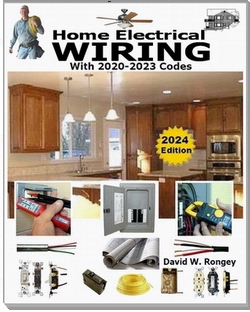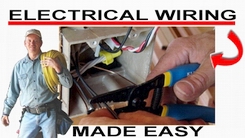» Generator Transfer Switches and Hook Up Portable Generator
» Need Electrical Help? Ask the Electrician
How to Select a Home Generator

|
Summary: Selecting and Sizing a Home Generator: How to rate a generator for your application requirements.This handy guide will help you understand generator ratings as it applies to your home generator project. © By: Dave Rongey |
Selecting a Home Generator for Your Application Requirements
There are a wide variety of portable generators that are available for purchase, however selecting the right generator for your project will require considerations about the rating and size.
Some generators are more suitable than others for the basic requirements of your home, and generally, many lower priced generators are not suitable for a home.
Small sized generators with a lower power output may not have sufficient engine durability to power your house during an extended power outage, and poor power quality can damage expensive electronic devices such as home office equipment and furnace controls.
|
Selecting the Right Voltage and Power Output
For basic home electrical loads you may wish to consider a generator with a 4-Wire 120/240 Volt configuration and a maximum power rating of 50 amps. The typical power connection supplied with the generator is a L1450P straight receptacle. Smaller size portable generators typically have a 30 amp rating with a L1430 locking receptacle, or a 20 amp rating with a L1420 locking receptacle.
|
Home Generator Cord Connectors Many electrical connectors that are only rated for 120 volt, or low amperage 240 volt are not appropriate for powering your home. If you have an existing transfer switch or generator panel with a cord connection, then make sure to purchase a generator that has the same receptacle specifications. Generators with a 30-Amp Rating Appliance Usage Guide The wattages presented in this table are estimates. Running Watts = Volts X Amps Rule of thumb: Allow 2kW per Horse Power for appliances with motors. Always use the starting wattage when calculating electrical load requirements for your generator. Select the appliances you want to operate and add the starting wattages together to determine if they can all be operated at the same time without exceeding the limits of your generator. Remember that circuit breakers usually control more than one appliance. |
| Click to Download » Generator Sizing Guidelines |
More about Selecting a Home Generator |
|
The Safest Way to Test Electrical Devices and Identify Electric Wires!The Non-Contact Electrical TesterThis is a testing tool that I have had in my personal electrical tool pouch for years, and is the first test tool I grab to help identify electrical wiring. It is a Non-contact tester that I use to easily Detect Voltage in Cables, Cords, Circuit Breakers, Lighting Fixtures, Switches, Outlets and Wires. Simply insert the end of the tester into an outlet, lamp socket, or hold the end of the tester against the wire you wish to test. Very handy and easy to use.
The Quickest Way to Check for Faulty Electrical Wiring!The Plug-In Outlet TesterThis is the first tool I grab to troubleshoot a problem with outlet circuit wiring. This popular tester is also used by most inspectors to test for power and check the polarity of circuit wiring. It detects probable improper wiring conditions in standard 110-125 VAC outlets Provides 6 probable wiring conditions that are quick and easy to read for ultimate efficiency Lights indicate if wiring is correct and indicator light chart is included Tests standard 3-wire outlets UL Listed Light indicates if wiring is incorrect Very handy and easy to use.
Strip Off Wire Insulation without Nicking and Damaging the Electric Wire!The Wire Stripper and Wire CutterMy absolute favorite wire stripping tool that I have had in my personal electrical tool pouch for years, and this is the tool I use to safely strip electrical wires. This handy tool has multiple uses: The wire gauges are shown on the side of the tool so you know which slot to use for stripping insulation. The end of the tool can be used to grip and bend wire which is handy for attaching wire onto the screw terminals of switches and outlets.. The wire stripper will work on both solid and stranded wire. This tool is Very Handy and Easy to Use. |
||














